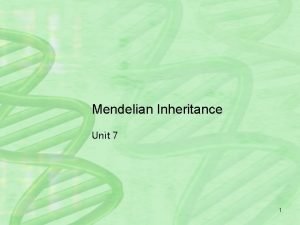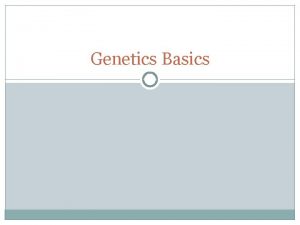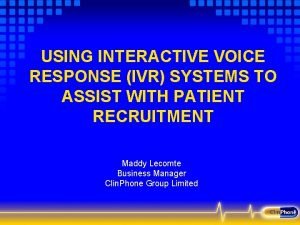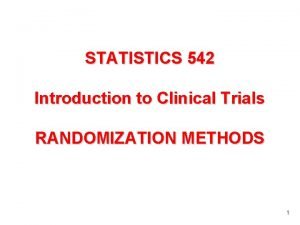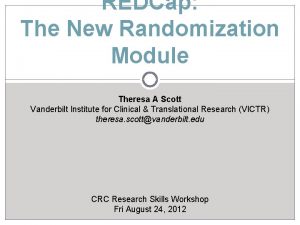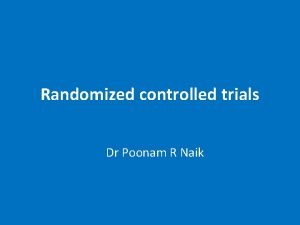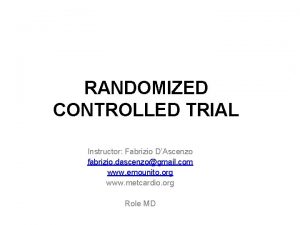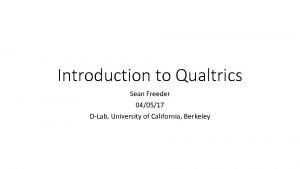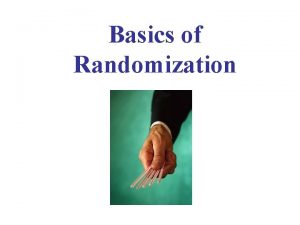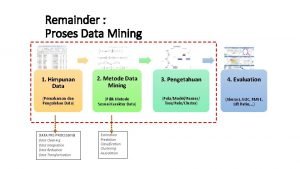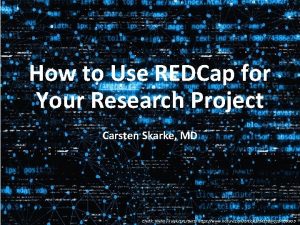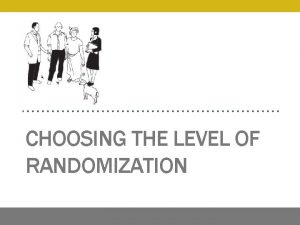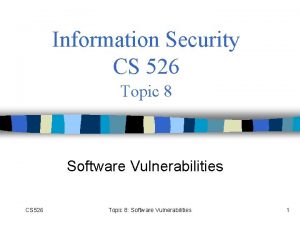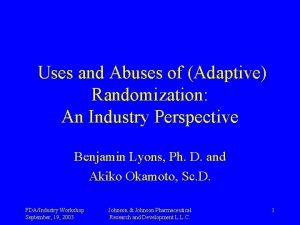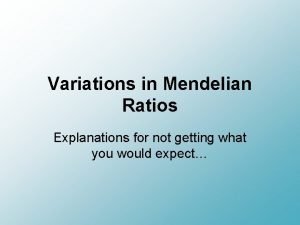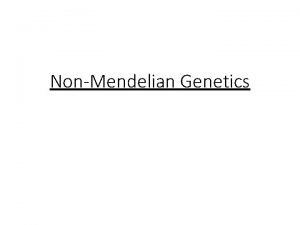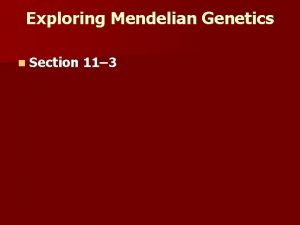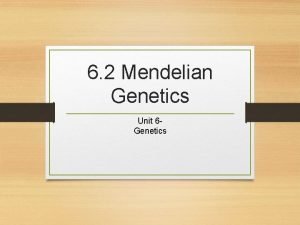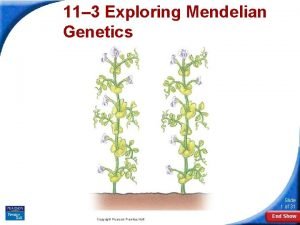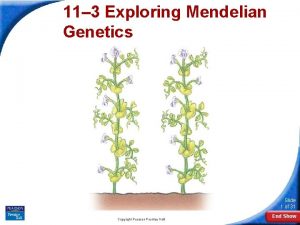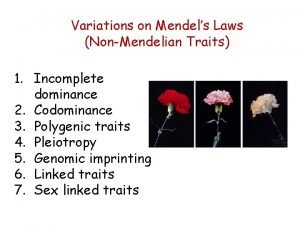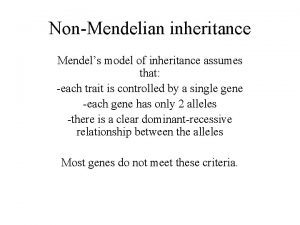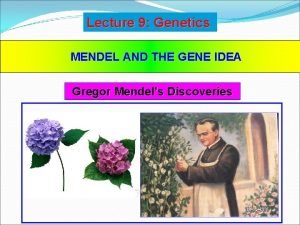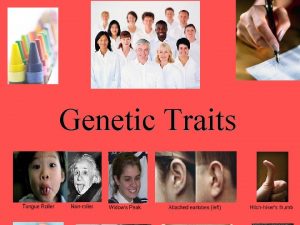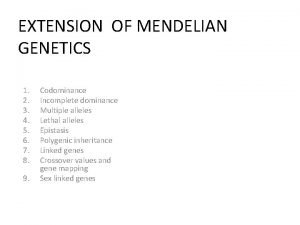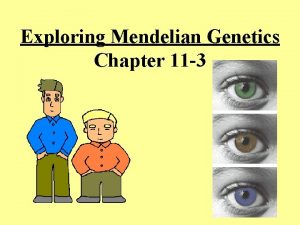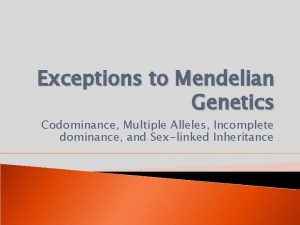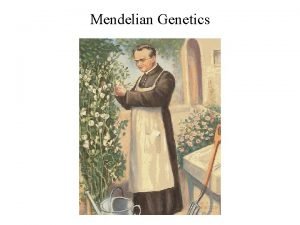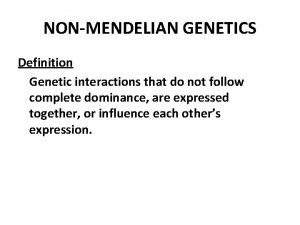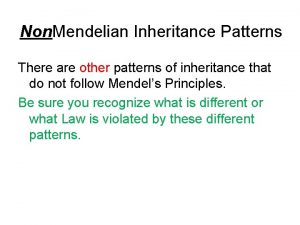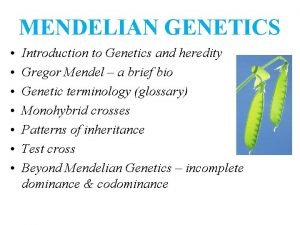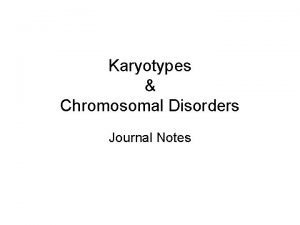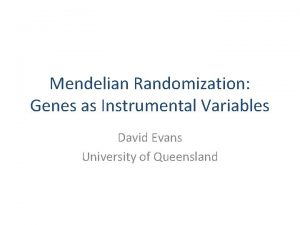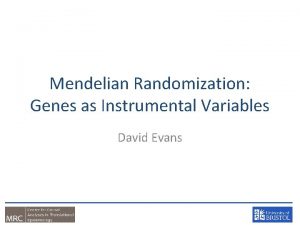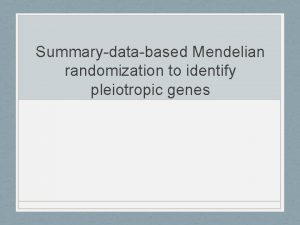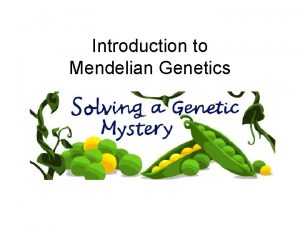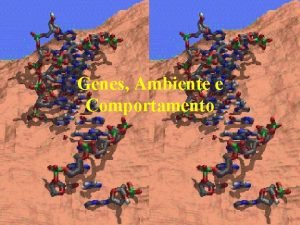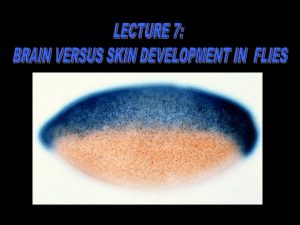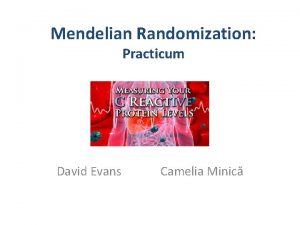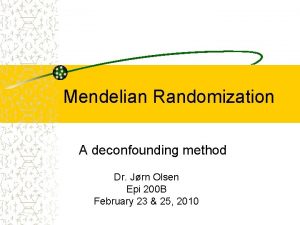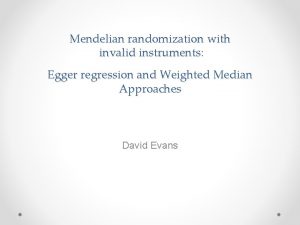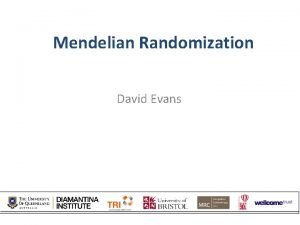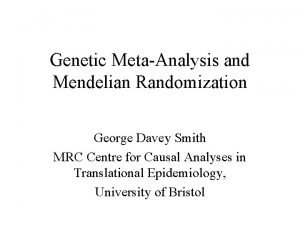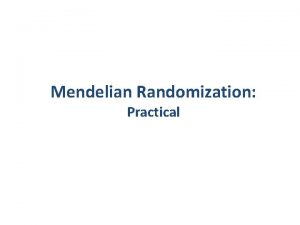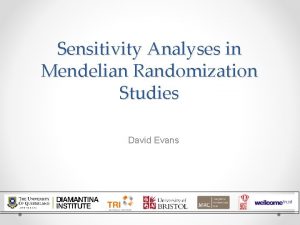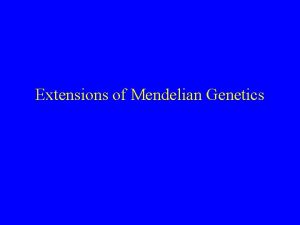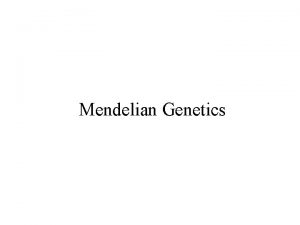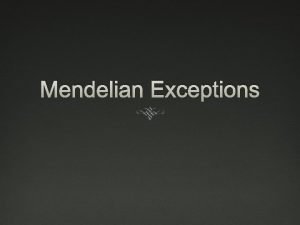Introduction to Mendelian Randomization Using genes to inform















































- Slides: 47

Introduction to Mendelian Randomization: Using genes to inform causality David Evans

Some Criticisms of Genetic Studies… • How do you translate the results from genetic studies? • You can’t change people’s genotypes (at least not yet) • You can however modify people’s environments… • Mendelian Randomization is a method of using genetics to inform us about associations in traditional observational epidemiology and MUCH more…

This Session • Randomized controlled trials • Problems with observational data • Mendelian Randomization (MR): – How it works – Core assumptions – Calculating causal effect estimates • MR example • Limitations of MR

RCTs: the Gold Standard in Inferring Causality RANDOMISED CONTROLLED TRIAL Randomization makes causal inference possible RANDOMIZATION METHOD EXPOSED: INTERVENTION CONTROL: NO INTERVENTION CONFOUNDERS EQUAL BETWEEN GROUPS OUTCOMES COMPARED BETWEEN GROUPS

The Need for Observational Studies • Randomized Controlled Trials (RCTs): – Not always ethical or practically feasible eg anything toxic – Expensive, requires experimentation in humans – Should only be conducted on interventions that show very strong observational evidence in humans • Observational studies: – Association between environmental exposures and disease measured in observational designs (non-experimental) eg case-control studies or cohort studies – Reliably assigning causality in these types of studies is very limited


CHD risk according to duration of current Vitamin E supplement use compared to no use RR Rimm et al NEJM 1993; 328: 1450 -6



Percent Use of vitamin supplements by US adults, 1987 -2000 Source: Millen AE, Journal of American Dietetic Assoc 2004; 104: 942 -950

Vitamin E supplement use and risk of Coronary Heart Disease 1. 0 Stampfer et al NEJM 1993; 328: 144 -9; Rimm et al NEJM 1993; 328: 1450 -6; Eidelman et al Arch Intern Med 2004; 164: 1552 -6

“Well, so much for antioxidants. ”

MANY OTHER EXAMPLES VITAMIN C, VITAMIN A, HRT, MANY DRUG TARGETS……. WHAT’S THE EXPLANATION?

Vitamin E levels and confounding risk factors: Childhood SES Manual social class No car access State pension only Smoker Obese Daily alcohol Exercise Low fat diet Height Leg length Women’s Heart and Health Study Lawlor et al, Lancet 2004

Classic limitations to “observational” science • Confounding • Reverse Causation • Bias

Mendelian randomization How can it help observational epidemiology?

What does MR do? • Assess causal relationship between two variables • Estimate magnitude of causal effect How does it do this? By harnessing Mendel’s laws of inheritance

Mendel’s Laws of Inheritance 1. Segregation: alleles separate at meiosis and a randomly selected allele is transmitted to offspring 2. Independent assortment: alleles for separate traits are transmitted independently of one another Mendel in 1862

Mendelian randomization and RCTs MENDELIAN RANDOMIZATION RANDOMISED CONTROLLED TRIAL + independent assortment RANDOM SEGREGATION OF ALLELES EXPOSED: FUNCTIONAL ALLELLES CONTROL: NULL ALLELLES CONFOUNDERS EQUAL BETWEEN GROUPS OUTCOMES COMPARED BETWEEN GROUPS RANDOMISATION METHOD EXPOSED: INTERVENTION CONTROL: NO INTERVENTION CONFOUNDERS EQUAL BETWEEN GROUPS OUTCOMES COMPARED BETWEEN GROUPS

Mendelian randomization: Smoking and Lung Cancer RANDOMISED CONTROLLED TRIAL MENDELIAN RANDOMIZATION + independent assortment RANDOM SEGREGATION OF ALLELES Heavy Smokers: C/C Light/Non Smokers: C/T or T/T CONFOUNDERS EQUAL BETWEEN GROUPS LUNG CANCER COMPARED BETWEEN GROUPS RANDOMISATION METHOD EXPOSED: SMOKERS CONTROL: NON SMOKERS CONFOUNDERS EQUAL BETWEEN GROUPS LUNG CANCER COMPARED BETWEEN GROUPS

Mendelian Randomization: 3 Core Assumptions Confounders (2) X SNP (1) Exposure Outcome X (3) (1) SNP is associated with the exposure (2) SNP is NOT associated with confounding variables (3) SNP ONLY associated with outcome through the exposure

Why are genetic associations special? • Robustness to confounding due to Mendel’s laws: – Law of segregation: inheritance of an allele is random and independent of environment etc – Law of independent assortment: genes for different traits segregate independently (assuming not in LD) • The direction of causality is known – always from SNP to trait • Genetic variants are potentially very good instrumental variables • Using genetic variants as IVs is a special case of IV analysis, known as Mendelian randomization

Calculating Causal Effect Estimates Confounders SNP Exposure Outcome βSNP-EXPOSURE ? β CAUSAL EXP-OUTCOME βSNP-OUTCOME After SNP identified robustly associated with exposure of interest: - Wald Estimator - Two-stage least-squares (TSLS) regression



MR can also be performed using just the results from GWAS • Also known as two-sample MR, SMR, or MR with summary data etc • Advantages: – The data is readily available, non-disclosive, free, open source – The exposure and outcome might not be measured in the sample – The sample size of the outcome variable, key to statistical power, is not limited by requiring overlapping measures of the exposure • Disadvantages: – Some extensions of MR not possible, e. g. non-linear MR, use of Gx. E for negative controls, various sensitivity analyses

Calculating Causal Effect Estimates Confounders SNP Exposure βSNP-EXPOSURE Outcome βCAUSAL EXP-OUTCOME βSNP-OUTCOME Causal effect by Wald Estimator* : ^ βSNP-OUTCOME ^β βSNP-OUTCOME = βCAUSAL EXP-OUTCOME x βSNP-EXPOSURE σSNP- OUTCOME Std Error Wald Estimator : ______ βSNP- EXPOSURE *Can be used in different samples (“Two sample MR”)

Calculating Causal Effect Estimates Confounders SNP βSNP-WEIGHT Weight 0. 5 kg βCAUSAL WEIGHT-BP BP βSNP-BP BP and weight: 0. 9 mm. Hg Causal effect by Wald Estimator* : ^β SNP-OUTCOME ^β SNP-EXPOSURE = change in outcome per unit change in exposure *Can be used in different samples (“Two sample MR”) 0. 9 mm. Hg/allele 0. 5 kg/allele =1. 8 mm. Hg/kg

Generate causal estimate Two-stage least squares library(sem) mod 1 <- tsls(outcome ~ exposure, ~ allele. score, data=data) # two-stage least squares with allele score mod 2 <- tsls(outcome ~ exposure, ~ rs 123 + rs 456 + rs 789 + rs 1011 + rs 1213, data=data) # two-stage least squares with individual SNPs library(AER) mod 3 <- ivreg(outcome ~ exposure | allele. score, data=data) mod 4 <- ivreg(outcome ~ exposure | rs 123 + rs 456 + rs 789 + rs 1011 + rs 1213, data=data)

MR Example using CRP • C-Reactive Protein (CRP) is a biomarker of inflammation • It is associated with BMI, metabolic syndrome, CHD and a number of other diseases • It is unclear whether these observational relationships are causal or due to confounding or reverse causality • This question is important from the perspective of intervention and drug development

Using a genetic instrument for proinflammatory CRP U CRP genotype CRP Cardiometabolic traits TWO ALTERNATIVES 1. If CRP DOES NOT causally affect cardiometabolic traits: CRP gene variant should NOT be related to cardiometabolic traits 2. If CRP CAUSALLY affects metabolic traits: CRP gene variant should also be related to these metabolic traits

“Bi-directional Mendelian Randomization”: Testing causality and reverse causation ? FTO Genotype CRP BMI ? CRP Genotype


Limitations to Mendelian Randomization 1 - Population stratification 2 - Canalisation (“Developmental compensation”) 3 - The existence of instruments 4 - Power and “weak instrument bias” 5 - Pleiotropy

Power and Weak Instruments • Power: – Genetic variants explain very small amounts of phenotypic variance in a given trait – VERY large sample sizes are generally required • Weak instruments: – Genetic variants that are weak proxies for the exposure – Results in biased causal estimates from MR • Different impact of the bias from weak instruments: – Single Sample MR: to the confounded estimate – Two-Sample MR: to the null

Using Multiple Genetic Variants as Instruments Palmer et al (2011) Stat Method Res • Allelic scores • Testing multiple variants individually • Meta-analyse individual SNPs

Calculating Power in Mendelian Randomization Studies

Limitations to Mendelian Randomization 1 - Population stratification 2 - Canalisation (“Developmental compensation”) 3 - The existence of instruments 4 - Power (also “weak instrument bias”) 5 - Pleiotropy

Pleiotropy • Genetic variant influences more than one trait • Horizontal vs Vertical pleiotropy Outcome Exposure G Vertical Pleiotropy Exposure Outcome G Horizontal Pleiotropy

Pleiotropy • Genetic variant influences more than one trait • Pleiotropy only violates MR’s assumptions if it involves a pathway outside that of the exposure and is a pathway that affects your outcome Violation Outcome Exposure B 1 Outcome B 2 G Exposure B 1 B 2 G

MR Base Jie “Chris” Zheng http: //www. mrbase. org/ Gib Hemani Phil Haycock






Useful References Brion et al (2013). Calculating statistical power in Mendelian randomization studies. Int J Epidemiol, 42(5), 1497501. Davey-Smith & Hemani (2014). Mendelian randomization: genetic anchors for causal inference in epidemiological studies. Hum Mol Genet, 23(1), R 89 -98. Davey-Smith & Ebrahim (2003). “Mendelian randomization”: can genetic epidemiology contribute to understanding environmental determinants of disease? IJE, 32, 1 -22. Davies et al (2018). Reading Mendelian randomization studies: a guide, glossary, and checklist for clinicians. BMJ, Jul 12, 362: k 601. Evans & Davey-Smith (2015). Mendelian randomization: New applications in the coming age of hypothesis free causality. Annu Rev Genomics Hum Genet, 16, 327 -50. Hemani et al. (2018). The MR-Base platform supports systematic causal inference across the human phenome. Elife, May 30, 7, e 34408. Zheng et al. (2017). Recent developments in Mendelian randomization studies. Curr Epidemiol Rep, 4(4), 330 -345.
 Family resemblance test
Family resemblance test Linked genes and unlinked genes
Linked genes and unlinked genes Glomerulus
Glomerulus Linked genes and unlinked genes
Linked genes and unlinked genes Heterozygous for type a blood
Heterozygous for type a blood Interactive voice response system randomization
Interactive voice response system randomization Stratified randomization
Stratified randomization Randomization redcap
Randomization redcap Poonam naik
Poonam naik Stratified randomization
Stratified randomization Randomize blocks in qualtrics
Randomize blocks in qualtrics Block randomization example
Block randomization example Randomization
Randomization Randomization based on remainder
Randomization based on remainder Upenn redcap
Upenn redcap Unit of randomization
Unit of randomization Address space layout randomization
Address space layout randomization Forced randomization
Forced randomization Permuted block randomization
Permuted block randomization Blood type matrix
Blood type matrix Non mendelian inheritance
Non mendelian inheritance Multiple alleles
Multiple alleles Drug
Drug Section 11-4 meiosis answer key
Section 11-4 meiosis answer key Chapter 7 extending mendelian genetics
Chapter 7 extending mendelian genetics Section 11-3 exploring mendelian genetics
Section 11-3 exploring mendelian genetics Chapter 10 section 2: mendelian genetics
Chapter 10 section 2: mendelian genetics Mendelian genetics punnett square
Mendelian genetics punnett square Section 11-3 exploring mendelian genetics
Section 11-3 exploring mendelian genetics 11-3 exploring mendelian genetics
11-3 exploring mendelian genetics Non mendelian law
Non mendelian law Non mendelian law
Non mendelian law Cystic fibrosis mendelian inheritance
Cystic fibrosis mendelian inheritance Extending mendelian genetics answer key
Extending mendelian genetics answer key Mendelian traits
Mendelian traits Pprr x pprr punnett square
Pprr x pprr punnett square Section 11-3 exploring mendelian genetics answer key
Section 11-3 exploring mendelian genetics answer key Hors xnxn
Hors xnxn Chapter 7 extending mendelian genetics vocabulary practice
Chapter 7 extending mendelian genetics vocabulary practice Pewarisan sifat non mendelian
Pewarisan sifat non mendelian Probability laws govern mendelian inheritance
Probability laws govern mendelian inheritance Phenotype simple definition
Phenotype simple definition Mendelian inheritance patterns
Mendelian inheritance patterns Co doninance
Co doninance Mendelian laws
Mendelian laws Chapter 10 sexual reproduction and genetics
Chapter 10 sexual reproduction and genetics Difference between mendelian and chromosomal disorders
Difference between mendelian and chromosomal disorders Inheritance
Inheritance
